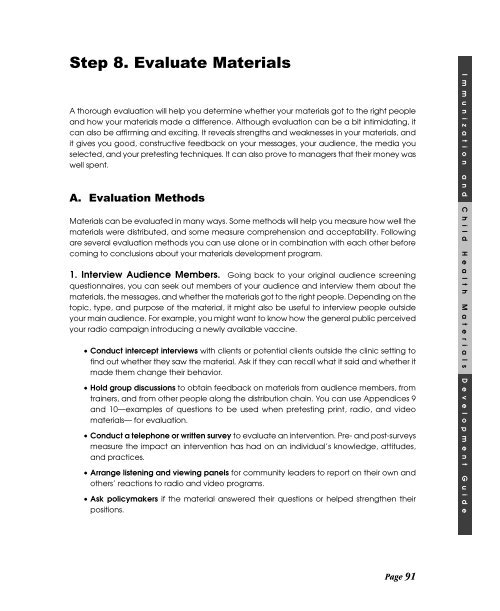Immunization and child health materials development guide pdf
Immunization and child health materials development guide pdf
Immunization and child health materials development guide pdf
You also want an ePaper? Increase the reach of your titles
YUMPU automatically turns print PDFs into web optimized ePapers that Google loves.
Step 8. Evaluate Materials<br />
A thorough evaluation will help you determine whether your <strong>materials</strong> got to the right people<br />
<strong>and</strong> how your <strong>materials</strong> made a difference. Although evaluation can be a bit intimidating, it<br />
can also be affirming <strong>and</strong> exciting. It reveals strengths <strong>and</strong> weaknesses in your <strong>materials</strong>, <strong>and</strong><br />
it gives you good, constructive feedback on your messages, your audience, the media you<br />
selected, <strong>and</strong> your pretesting techniques. It can also prove to managers that their money was<br />
well spent.<br />
A. Evaluation Methods<br />
Materials can be evaluated in many ways. Some methods will help you measure how well the<br />
<strong>materials</strong> were distributed, <strong>and</strong> some measure comprehension <strong>and</strong> acceptability. Following<br />
are several evaluation methods you can use alone or in combination with each other before<br />
coming to conclusions about your <strong>materials</strong> <strong>development</strong> program.<br />
1. Interview Audience Members. Going back to your original audience screening<br />
questionnaires, you can seek out members of your audience <strong>and</strong> interview them about the<br />
<strong>materials</strong>, the messages, <strong>and</strong> whether the <strong>materials</strong> got to the right people. Depending on the<br />
topic, type, <strong>and</strong> purpose of the material, it might also be useful to interview people outside<br />
your main audience. For example, you might want to know how the general public perceived<br />
your radio campaign introducing a newly available vaccine.<br />
• Conduct intercept interviews with clients or potential clients outside the clinic setting to<br />
find out whether they saw the material. Ask if they can recall what it said <strong>and</strong> whether it<br />
made them change their behavior.<br />
• Hold group discussions to obtain feedback on <strong>materials</strong> from audience members, from<br />
trainers, <strong>and</strong> from other people along the distribution chain. You can use Appendices 9<br />
<strong>and</strong> 10—examples of questions to be used when pretesting print, radio, <strong>and</strong> video<br />
<strong>materials</strong>— for evaluation.<br />
• Conduct a telephone or written survey to evaluate an intervention. Pre- <strong>and</strong> post-surveys<br />
measure the impact an intervention has had on an individual’s knowledge, attitudes,<br />
<strong>and</strong> practices.<br />
• Arrange listening <strong>and</strong> viewing panels for community leaders to report on their own <strong>and</strong><br />
others’ reactions to radio <strong>and</strong> video programs.<br />
• Ask policymakers if the material answered their questions or helped strengthen their<br />
positions.<br />
Page 91

















